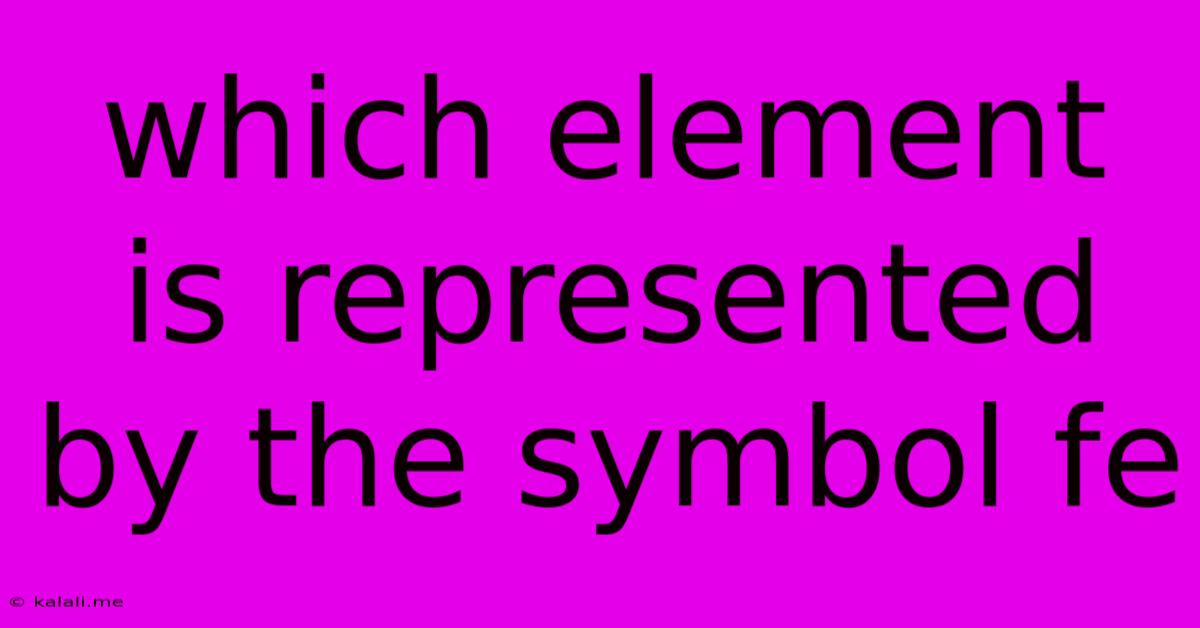Which Element Is Represented By The Symbol Fe
Kalali
Jun 13, 2025 · 3 min read

Table of Contents
Which Element is Represented by the Symbol Fe?
Iron: The Element Represented by Fe
The chemical symbol Fe represents the element iron. This is a fundamental piece of knowledge in chemistry and is frequently encountered in various scientific contexts, from basic chemistry classes to advanced materials science. This article delves deeper into the properties and significance of iron, exploring its history, uses, and importance in various fields.
Iron (Fe) is a transition metal with atomic number 26. It is abundant in the Earth's crust and plays a crucial role in many biological processes. Understanding its properties and applications is essential for anyone studying chemistry, biology, geology, or materials science.
Properties of Iron (Fe)
- Atomic Number: 26
- Atomic Weight: 55.845 u
- Symbol: Fe (from the Latin word ferrum)
- Electron Configuration: [Ar] 3d<sup>6</sup> 4s<sup>2</sup>
- Appearance: Silvery-grey, lustrous metal
- Melting Point: 1538 °C (2800 °F)
- Boiling Point: 2862 °C (5184 °F)
- Density: 7.874 g/cm³
- Hardness: Relatively hard, but malleable and ductile
Iron's properties make it incredibly versatile. Its high melting and boiling points contribute to its strength and durability, while its malleability and ductility allow it to be shaped and formed into various products. These characteristics, alongside its reactivity, explain its wide range of applications.
Uses and Applications of Iron
The applications of iron are vast and diverse, impacting nearly every aspect of modern life. Some key examples include:
- Steel Production: The most significant use of iron is in the production of steel, an alloy of iron and carbon, which exhibits improved strength and other desirable properties. Steel forms the backbone of many structures, from skyscrapers and bridges to vehicles and appliances.
- Cast Iron: Another important iron alloy, cast iron is known for its high compressive strength and is used in various applications like engine blocks, pipes, and cookware.
- Magnetic Applications: Iron’s ferromagnetic properties are crucial in many applications, including electric motors, generators, and transformers. Electromagnets, a key component in many devices, rely on iron's ability to be easily magnetized and demagnetized.
- Biological Significance: Iron is an essential element for life, playing a vital role in oxygen transport in hemoglobin (in red blood cells) and in various enzyme functions. Iron deficiency can lead to anemia.
- Construction and Infrastructure: From reinforcement bars in concrete to structural beams in buildings, iron plays a dominant role in construction and infrastructure projects worldwide.
Iron's Significance and Future Prospects
Iron's significance in human history is undeniable. The Iron Age marked a major technological leap, and its continued importance is evident in its ubiquitous presence in modern society. Ongoing research into iron and its alloys continues to yield advancements in materials science, leading to stronger, lighter, and more corrosion-resistant materials. The quest for sustainable and efficient iron production methods also remains an active area of research.
In conclusion, the chemical symbol Fe unequivocally represents iron, an element crucial to both technological advancement and biological life. Its unique properties and widespread applications highlight its continuing importance in various scientific disciplines and aspects of modern civilization.
Latest Posts
Latest Posts
-
Words To Describe A Great Mother
Jun 14, 2025
-
Which Of The Following Statements Are True About Language
Jun 14, 2025
-
An Increase In The General Level Of Prices
Jun 14, 2025
-
Which Of The Following Is The Correct Formula
Jun 14, 2025
-
Why Are Sound Waves Called Mechanical Waves
Jun 14, 2025
Related Post
Thank you for visiting our website which covers about Which Element Is Represented By The Symbol Fe . We hope the information provided has been useful to you. Feel free to contact us if you have any questions or need further assistance. See you next time and don't miss to bookmark.